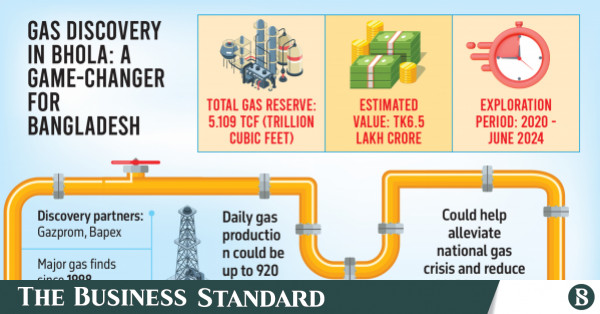Massive 5tcf gas reserve found in Bhola, valued at Tk6.5 lakh crore


The joint study began in 2020 and concluded in June 2024. The findings have been submitted to the Ministry of Power, Energy and Mineral Resources, the Bangladesh Oil, Gas and Mineral Corporation (Petrobangla), and Bapex
Infographic: TBS
“>
Infographic: TBS
A potential gas reserve of 5.109 trillion cubic feet (tcf) has been discovered in Bhola, a southern island district of Bangladesh, according to a joint study by Russian energy giant Gazprom and the Bangladesh Petroleum Exploration and Production Company Limited (Bapex).
Energy experts say 1tcf of gas can meet the country’s annual gas demand.
The research included a 600 square kilometre 3D seismic survey from Shahbazpur to Elisha, which found a recoverable reserve of 2.423tcf. An additional 152.6-line-km 2D seismic survey in Char Fasson found another 2.686tcf, according to Bapex.
The joint study began in 2020 and concluded in June 2024. The findings have been submitted to the Ministry of Power, Energy and Mineral Resources, the Bangladesh Oil, Gas and Mineral Corporation (Petrobangla), and Bapex.
The research report indicates a 10% chance of finding 2.423tcf of gas in Shahbazpur and Elisha, and 2.686tcf in Char Fasson, totalling 5.109tcf. At the current LNG spot market price of $10.46 per million British thermal unit (MMBtu), this gas reserve is valued at approximately Tk6.5 lakh crore.
The report also shows a 50% chance of discovering 3.391tcf of gas at these sites and a 90% chance of finding at least 1.809tcf.
Alamgir Hossain, former general manager of Bapex’s Geological Department, told The Business Standard, “There is a possibility of finding more than 5tcf of gas. Historically, while studies estimated 2tcf, actual extraction has reached up to 3 or 4tcf.”
This discovery is significant, being the largest since the Bibiyana gas field was found in 1998. Although the Shahbazpur field was discovered in the mid-1990s, it was considered small until this recent study.
Muhammad Amirul Islam, a researcher involved in the study and a representative of Norwegian multinational energy company Statoil (now Equinor), told TBS, “This research meets international standards and relies on seismic data, oil lock data, core samples, and advanced technology like supercomputers and top-quality labs.
“These methods ensure the findings are reliable. If development projects based on this research go ahead, they could cover a significant part of Bangladesh’s energy needs.”
He added, “Drilling at least 49 new wells in the entire Bhola area could address household and CNG gas shortages, help reduce inflation, and lower the cost of goods.”
Petrobangla Chairman Janendra Nath Sarkar told TBS, “We have a Memorandum of Understanding with Russian Gazprom to explore and survey gas. The Bhola region has significant potential. We plan to connect Bhola’s gas to the national grid with pipelines running from Bhola to Barisal and then from Barisal to Khulna.
“We also aim to transport gas to Dhaka using LNG and CNG methods. Tenders for these projects will be available soon, inviting multiple companies to participate. Additionally, we are working to cut LNG imports and boost domestic gas supply.”
The research report states that Bhola currently has 5 wells producing 80 million cubic feet of gas per day (mmcfd). Four more wells are ready, which could add another 80mmcfd. Additionally, 5 proposed wells could supply 100mmcfd within two years. There are 14 other well sites that might produce 210mmcfd.
In Char Fasson, six geological structures have been identified where 30 wells could be drilled, potentially producing 450mmcfd. If all these wells are operational, daily production in Bhola could reach 920mmcfd, which would help ease the gas crisis and reduce dependence on expensive LNG imports.
Geologist and energy expert Prof Badrul Imam said, “Bhola and Sylhet are our most promising gas-rich regions. We need to speed up drilling operations in Bhola and prioritise building the gas pipeline.”
However, he cautioned against relying only on Bapex for exploration, as the company’s capacity is still growing. “Joint exploration with Petrobangla and foreign companies would be more effective in boosting domestic gas production,” he added.
Gazprom, which has been active in Bangladesh for over a decade, has drilled 20 wells, adding around 4.5tcf to the gas reserves. These wells currently produce 300mmcfd.
Petrobangla officials noted that Bhola’s gas fields were discovered 30 years ago, but pipeline construction was delayed due to economic concerns. With increased reserves, plans for pipeline construction are now moving forward. Currently, Bhola’s gas is supplied on a limited scale to local power plants and small industries.
The country’s daily gas demand is about 4,000mmcfd, but only 2,633mmcfd is supplied, creating a shortfall of 1,367mmcfd. To address this deficit, Bangladesh relies heavily on imported LNG.
However, the closure of one of Summit’s floating LNG terminals for over three months has reduced LNG supply by 500mmcfd, worsening the gas shortage for industries and power plants.
Various sectors affected by gas crisis
Gas-based industries, such as those in spinning, dyeing, printing, cement, ceramics, and iron and steel, have seen their production fall below 30% because of the gas shortage.
Around 700 textile factories, part of the Bangladesh Textile Mills Association, are facing severe disruptions.
Factory owners report that they need 15 pounds per square inch (PSI) of pressure for boiler operation, but many are only receiving between 1.5 and 3 PSI, with some getting no gas at all. This has caused major production issues.
CNG filling stations also suffer from low gas pressure, leading to long queues of vehicles waiting to refuel. The gas exploration potential in Bhola could help address these problems.




